A Conceptual Model for Spatial Grain Size Variability on the Surface of and within Beaches
Abstract
:1. Introduction
2. Materials and Methods
2.1. Experiment
2.2. Cores
2.3. Core Processing
2.4. Digital Imaging System
2.5. Trenches
2.6. Changes in Beach Elevation Change and the Active Layer
3. Results
3.1. Core Observation
3.2. Trench Observations
3.3. Depth of Disturbance Observations
4. Discussion
5. Conclusions
Acknowledgments
Author Contributions
Conflicts of Interest
References
- Komar, P.D. Beach Processes and Sedimentation; Prentice-Hall: Upper Saddle River, NJ, USA, 1998. [Google Scholar]
- Nielsen, P. Coastal and Estuarine Processes; World Scientific Press: Singapore, 2009. [Google Scholar]
- Holland, K.T.; Elmore, P.A. A review of heterogeneous sediments in coastal environments. Earth-Sci. Rev. 2008, 89, 116–134. [Google Scholar] [CrossRef]
- Buscombe, D.; Masselink, G. Concepts in gravel beach dynamics. Earth-Sci. Rev. 2006, 79, 33–52. [Google Scholar] [CrossRef]
- Hay, A.E.; Zedel, L.; Stark, N. Sediment dynamics on a steep, megatidal, mixed sand-gravel-cobble beach. Earth Surf. Dyn. 2014, 2, 443–453. [Google Scholar] [CrossRef]
- Ivamy, M.C.; Kench, P.S. Hydrodynamics and morphological adjustment of a mixed sand and gravel beach, Torere, Bay of Plenty, New Zealand. Mar. Geol. 2006, 228, 137–152. [Google Scholar] [CrossRef]
- Mason, T.; Coates, T. Sediment transport processes on mixed beaches: A review for shoreline management. J. Coast. Res. 2001, 17, 645–657. [Google Scholar]
- Otvos, E.G. Sedimentation-erosion cycles of single tidal periods on Long Island Sound beaches. J. Sed. Pet. 1965, 35, 604–609. [Google Scholar]
- Duncan, J.R. The effects of water table and tide cycle on swash-backwash sediment distribution and beach profile development. Mar. Geol. 1964, 2, 186–197. [Google Scholar] [CrossRef]
- Gallagher, E.L.; MacMahan, J.H.; Reniers, A.J.H.M.; Brown, J.; Thornton, E.B. Grain size variability on a rip-channeled beach. Mar. Geol. 2011, 287, 43–53. [Google Scholar] [CrossRef]
- Reniers, A.J.H.M.; Gallagher, E.L.; MacMahan, J.H.; Brown, J.A.; van Rooijen, A.A.; van Thiel de Vries, J.S.M.; van Prooijen, B.C. Observations and modeling of steep-beach grain-size variability. J. Geophys. Res. Oceans 2013, 118, 577–591. [Google Scholar] [CrossRef]
- Neal, A.; Pontee, N.I.; Pye, K.; Richards, J. Internal structure of mixed-sand-and-gravel beach deposits revealed using ground-penetrating radar. Sedimentology 2002, 49, 789–804. [Google Scholar]
- Plant, N.; Holland, K.T.; Puleo, J.; Gallagher, E.L. Predictions skill of nearshore profile evolution models. J. Geophys. Res. 2004, 109, C01006. [Google Scholar] [CrossRef]
- Castelle, B.; Ruessink, B.G.; Bonneton, P.; Marieu, V.; Bruneau, N.; Price, T. Coupling mechanisms in double sandbar systems, Part 1: Patterns and physical explanation. Earth Surf. Process. Landf. 2010, 35, 476–486. [Google Scholar] [CrossRef]
- Roelvink, J.A.; Reniers, A.J.H.M. Guide to Modeling Coastal Morphology; World Scientific Press: Singapore, 2011. [Google Scholar]
- Johnson, B.D.; Kobayashi, N.; Gravens, M.B. Cross-shore numerical model CSHORE for waves, currents, sediment transport and beach profile evolution. In Proceedings of the Great Lakes Coastal Flood Study, 2012 Federal Inter-Agency Intiative, Washington, DC, USA, September 2012.
- Nielsen, P.; Callaghan, D.P. Shear stress and sediment transport calculations for sheet flow under waves. Coast. Eng. 2003, 47, 347–354. [Google Scholar] [CrossRef]
- Roelvink, J.A.; Reniers, A.J.H.M.; van Dongeren, A.R.; van Thiel de Vries, J.S.M.; McCall, R.T.; Lescinski, J. Modeling storm impacts on beaches, dunes and barrier islands. Coast. Eng. 2009, 56, 1133–1152. [Google Scholar] [CrossRef]
- Hoefel, F.; Elgar, S. Wave induced sediment transport and sand bar migration. Science 2003, 299, 1885. [Google Scholar] [CrossRef] [PubMed]
- Blondeaux, P. Sediment mixtures, coastal bedforms and grain sorting phenomena: An overview of theoretical analyses. Adv. Water. Res. 2012, 48, 113–124. [Google Scholar] [CrossRef]
- Soulsby, R. Dynamics of Marine Sands; Thomas Telford Limited: London, UK, 1997. [Google Scholar]
- Gallagher, E.L.; Elgar, S.; Guza, R.T. Observations of sand bar evolution on a natural beach. J. Geophys. Res. 1998, 103, 3203–3215. [Google Scholar] [CrossRef]
- Ruessink, B.; Kuriyama, Y.; Reniers, A.J.H.M.; Roelvink, J.A.; Walstra, D. Modeling cross-shore sandbar behavior on the timescale of weeks. J. Geophys. Res. 2007, 112, F03010. [Google Scholar] [CrossRef]
- Gallagher, E.L.; Reniers, A.J.H.M.; Wadman, H.; McNinch, J.; MacMahan, J. Onservations and modeling of grain size variability on and in a steep beach. In Proceedings of the AGU Ocean Sciences Meeting 2014, American Geophysical Union, Honolulu, HI, USA, February 2014.
- Rubin, D.M. A simple autocorrelation algorithm for determining grain size from digital images of sediment. J. Sediment. Res. 2004, 74, 160–165. [Google Scholar] [CrossRef]
- Brodie, K.L.; Raubenheimer, B.; Elgar, S.; Slocum, R.K.; McNinch, J.E. Lidar and Pressure Measurements of Inner-Surfzone Waves and Setup. J. Atm. Ocean. Tech. 2015, 32, 1945–1959. [Google Scholar] [CrossRef]
- Wadman, H.M. Controls on continental shelf stratigraphy, Waiapu River, New Zealand. Ph.D. Thesis, Virginia Institute of Marine Science, College of William and Mary, Williamsburg, VA, USA, May 2008. [Google Scholar]
- Foxgrover, A.C. Quantifying the overwash component of barrier island morphodynamics, Onslow Beach, NC. Master’s Thesis, Virginia Institute of Marine Science, College of William and Mary, Williamsburg, VA, USA, May 2008. [Google Scholar]
- Wadman, H.M.; McNinch, J.E. Integrating subaerial and nearshore geologic metrics for predicting shoreline change: Onslow Beach. In Proceedings of the 7th International Symposium on Coastal Engineering and Science of Coastal Sediment Processes, Miami, FL, USA, 2–6 May 2011.
- Stauble, D.K.; Cialone, M.A. Sediment dynamics and profile interactions: Duck94. Proc. Inter. Conf. Coast. Eng. 1996, 4, 3921–3934. [Google Scholar]
- Puleo, J.A.; Lanckriet, T.; Blenkinsopp, C. Bed level fluctuatios in the inner surf and swash zone of a dissipative beach. Mar. Geol. 2014, 349, 99–112. [Google Scholar] [CrossRef]
- Turner, I.L.; Russell, P.E.; Butt, T. Measurement of wave-by-wave bed-levels in the swash zone. Coast. Eng. 2008, 55, 1237–1242. [Google Scholar] [CrossRef]
- Blenkinsopp, C.E.; Turner, I.L.; Masselink, G.; Russell, P.E. Swash zone sediment fluxes: Field observations. Coast. Eng. 2011, 58, 28–44. [Google Scholar] [CrossRef]
- Brodie, K.L.; McNinch, J.E. Measuring Bathymetry, Runup, and Beach Volume Change during Storms: New Methodology Quantifies Substantial Changes in Cross-Shore Sediment Flux. In Proceedings of the American Geophysical Union, Fall Meeting 2009, San Francisco, CA, USA, December 2009.
- Brodie, K.L. Processes driving storm-scale coastal change along the Outer Banks, North Carolina: Insights from during-storm observations using CLARIS. In Proceedings of the American Geophysical Union, Fall Meeting 2010, San Francisco, CA, USA, December 2010.
- Roberts, T.M.; Wang, P.; Puleo, J.A. Storm-driven cyclic beach morphodynamics of a mixed sand and gravel beach along the Mid-Atlantic coast, USA. Mar. Geol. 2013, 346, 403–421. [Google Scholar] [CrossRef]
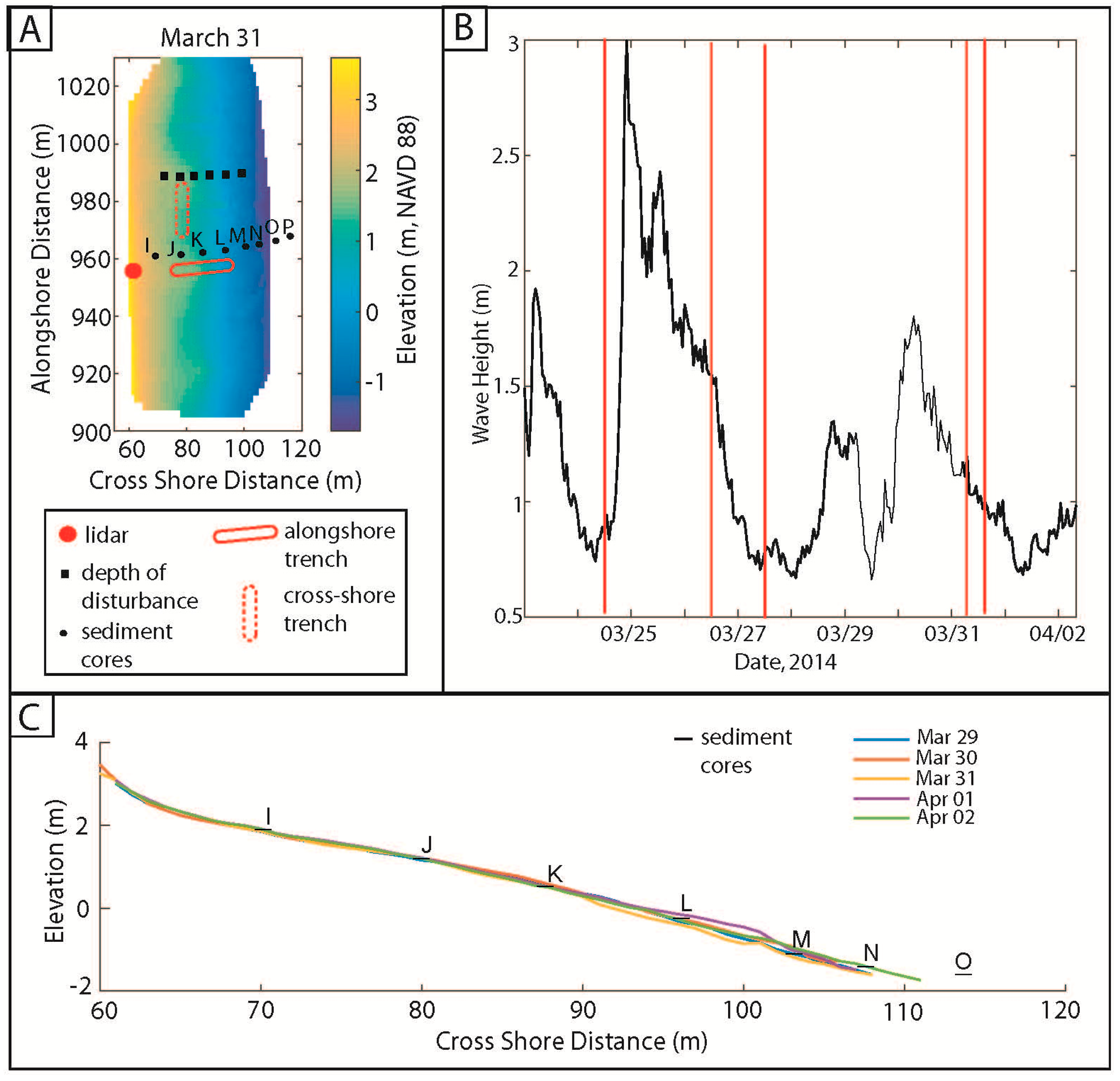
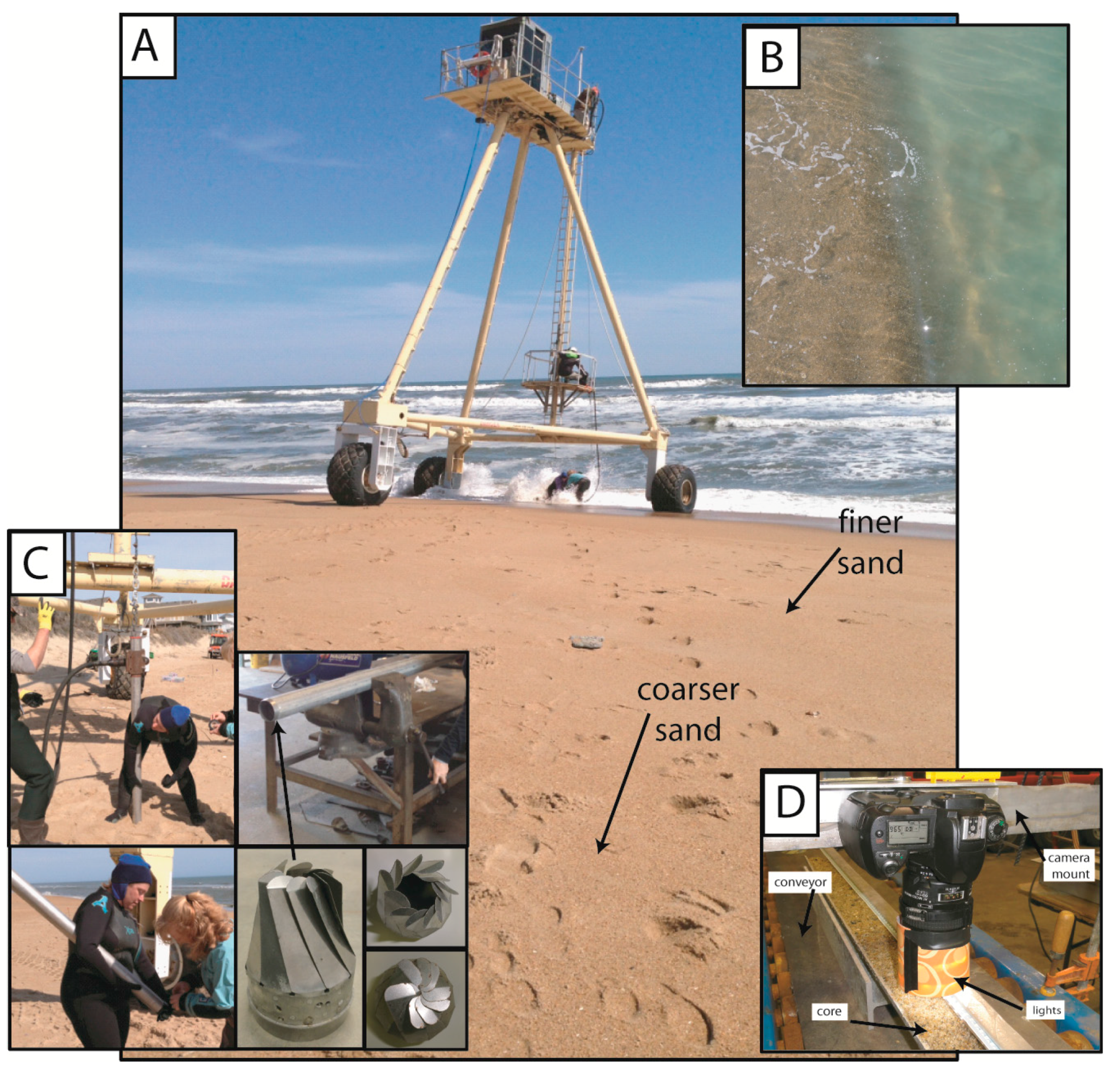
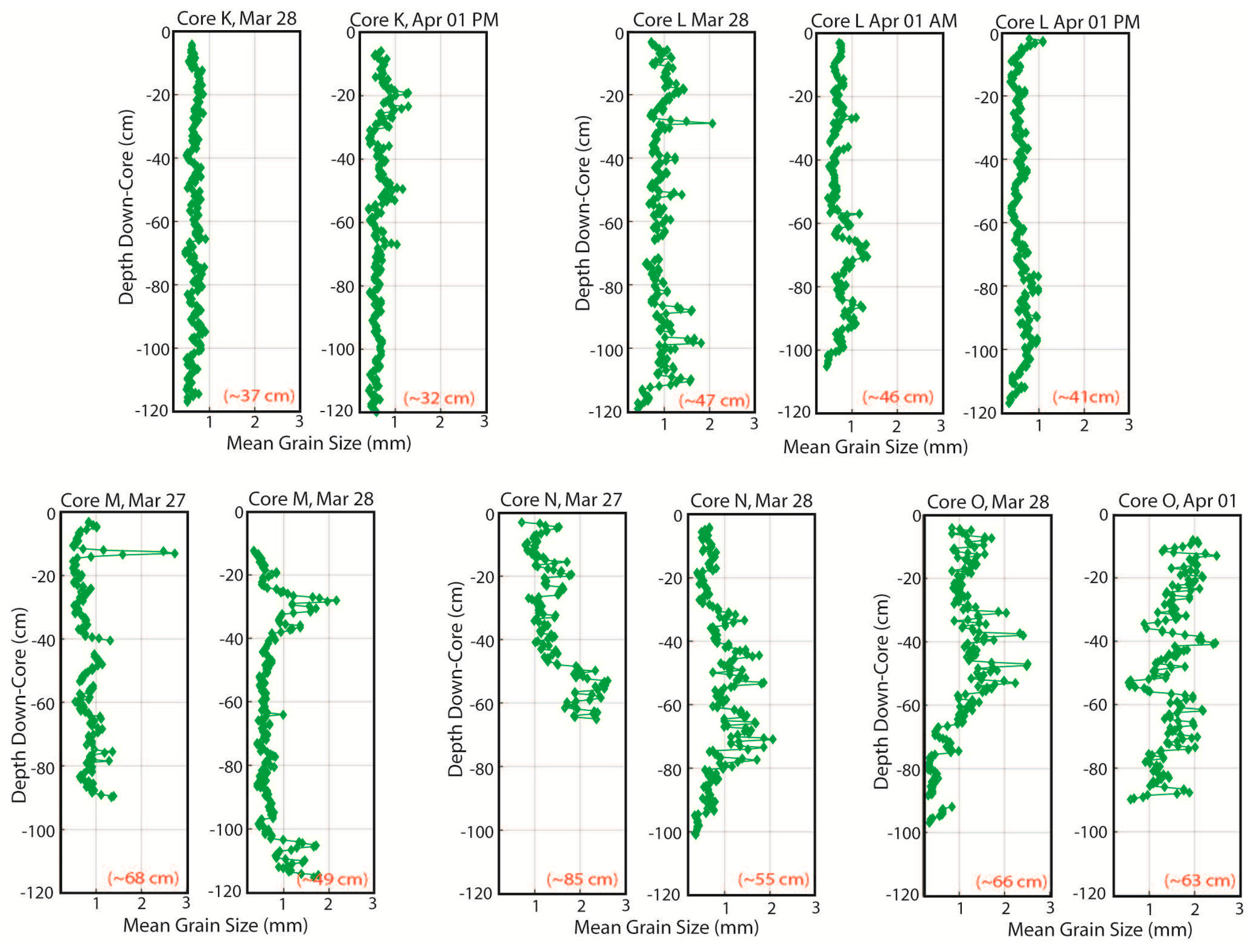
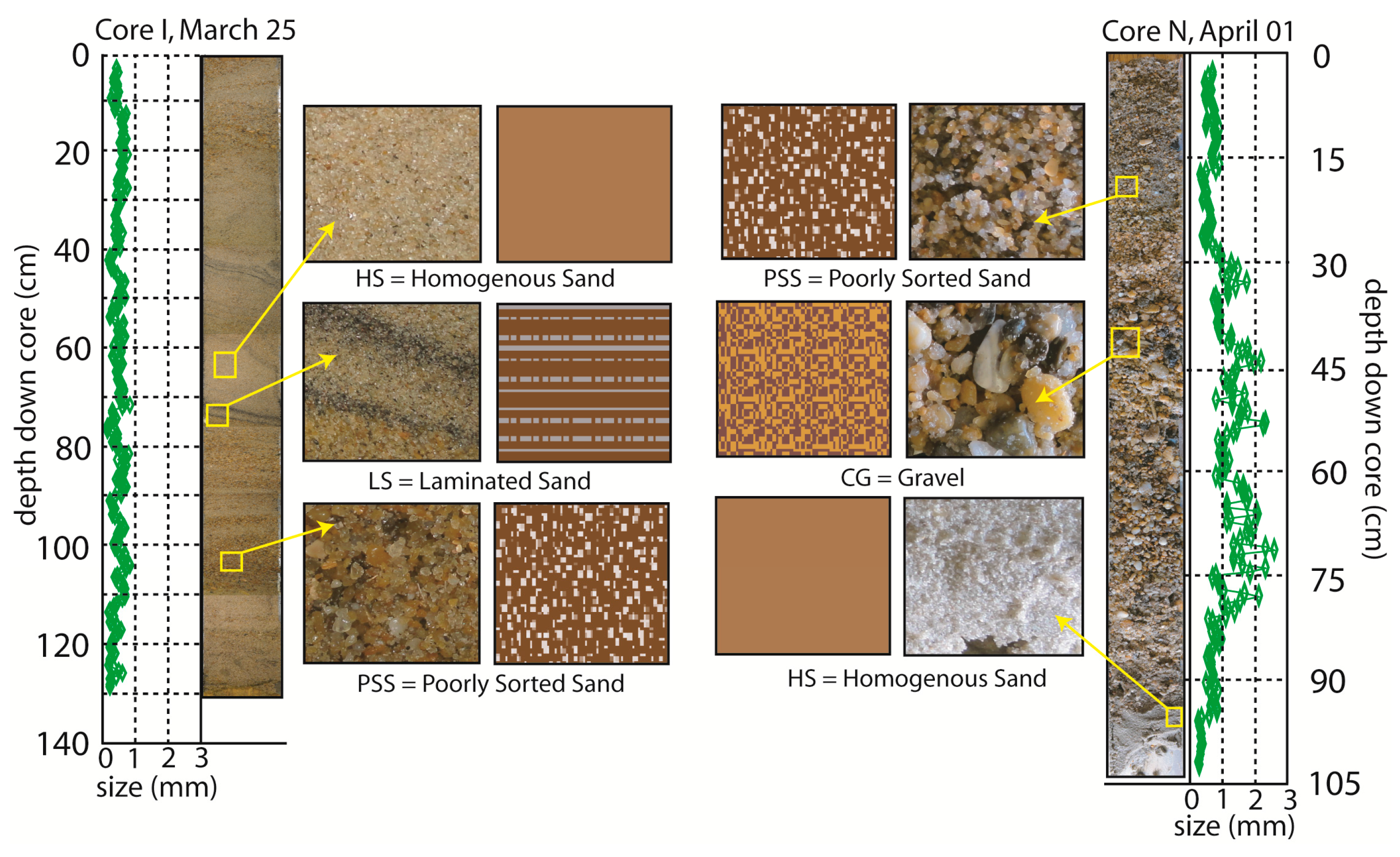
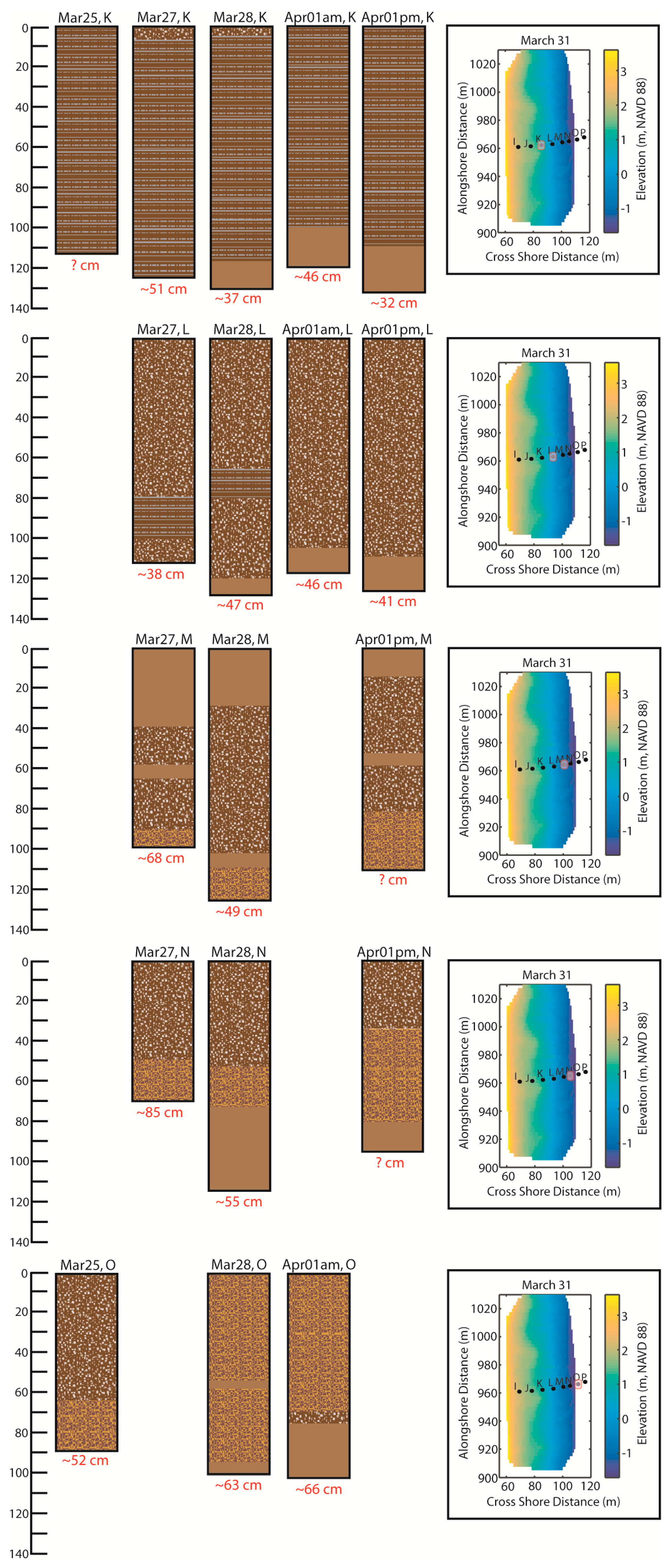
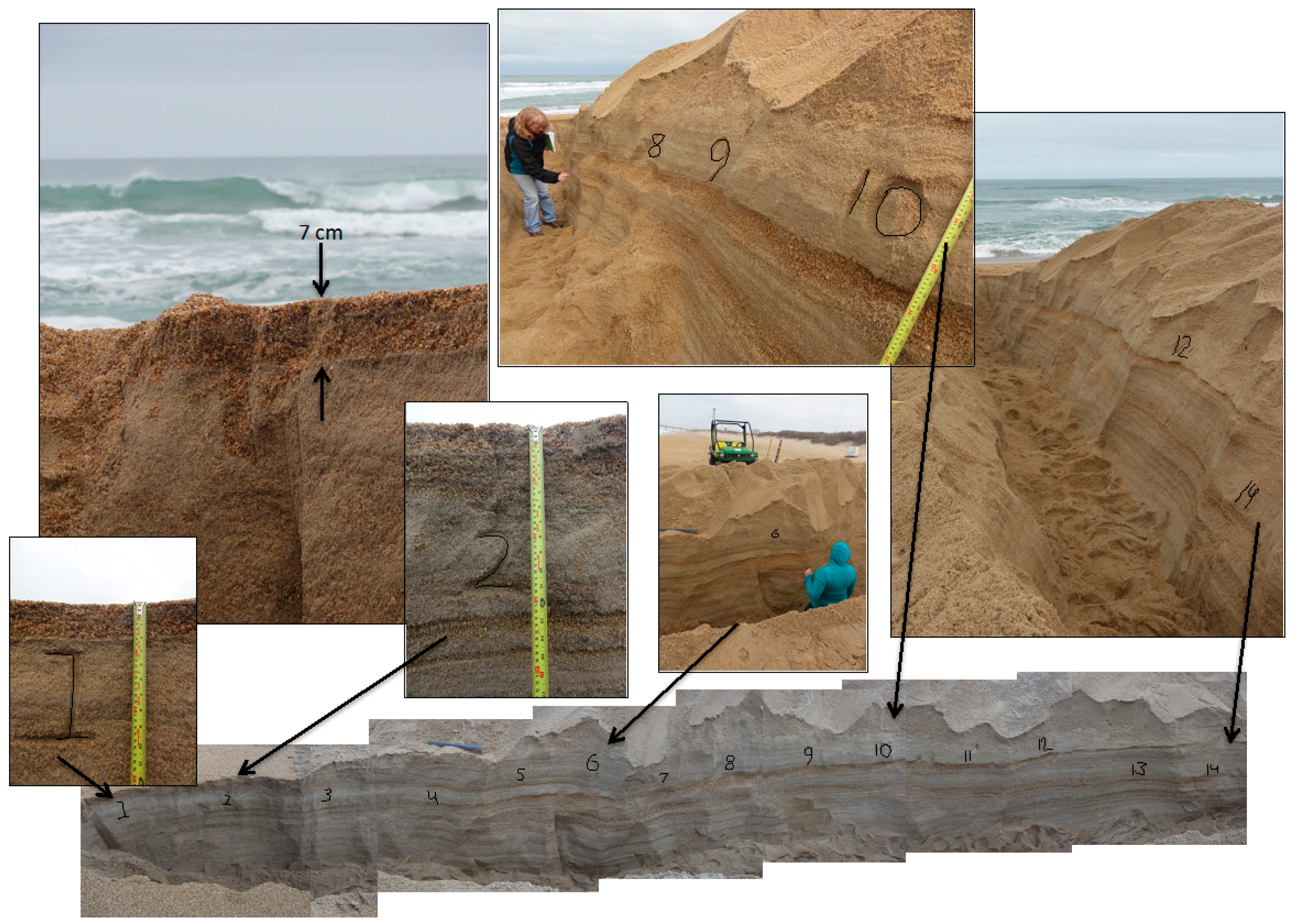

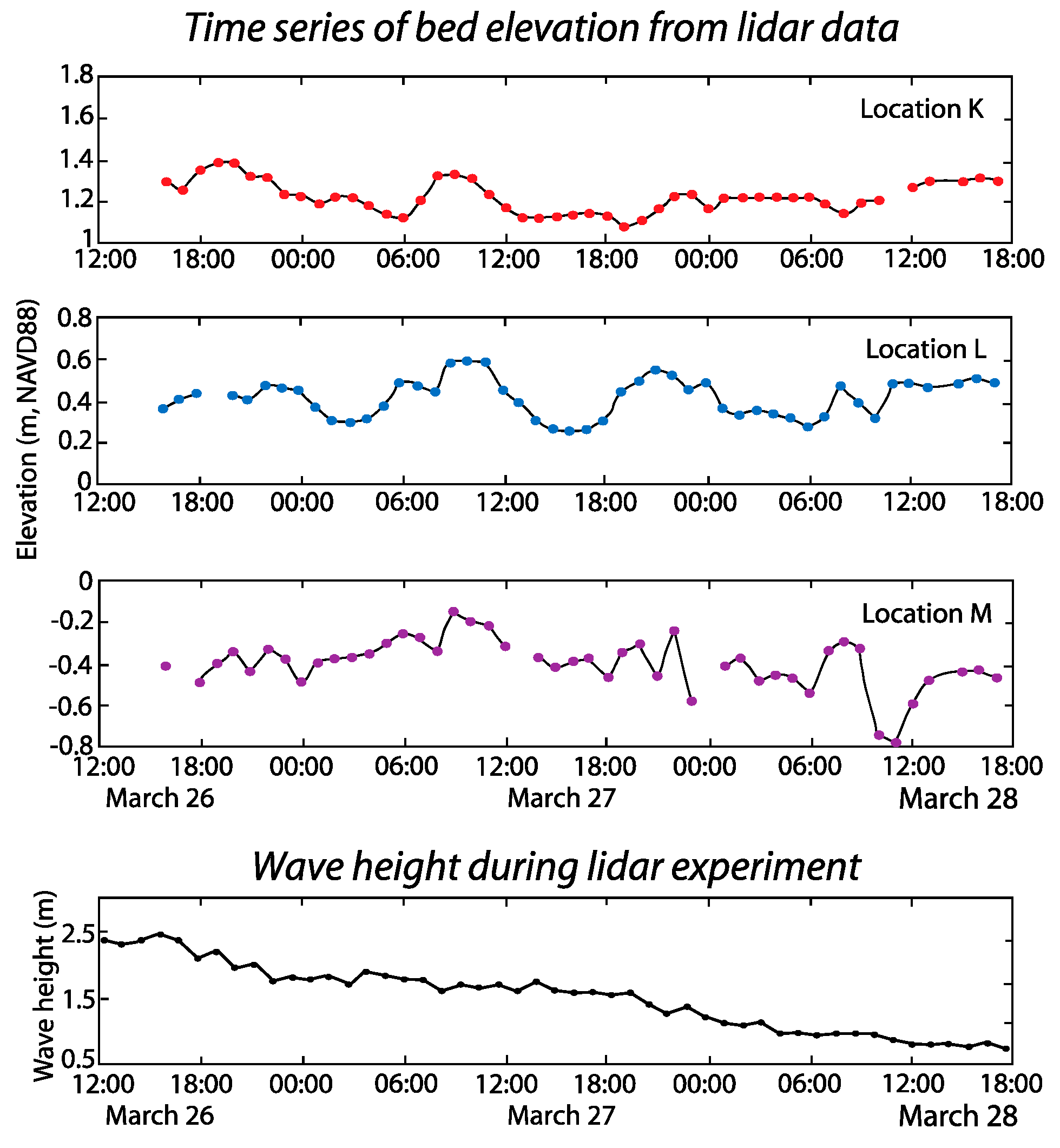

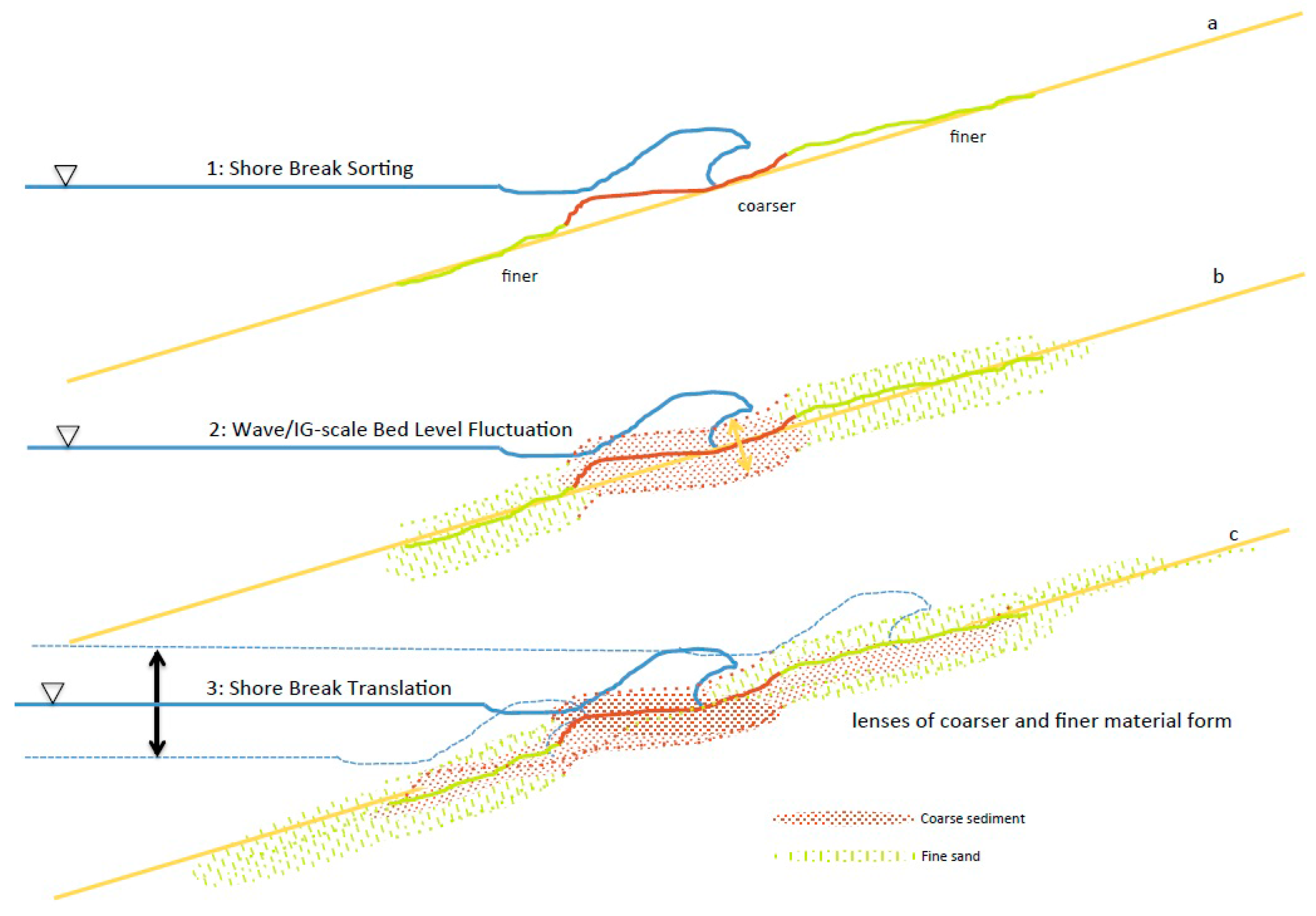
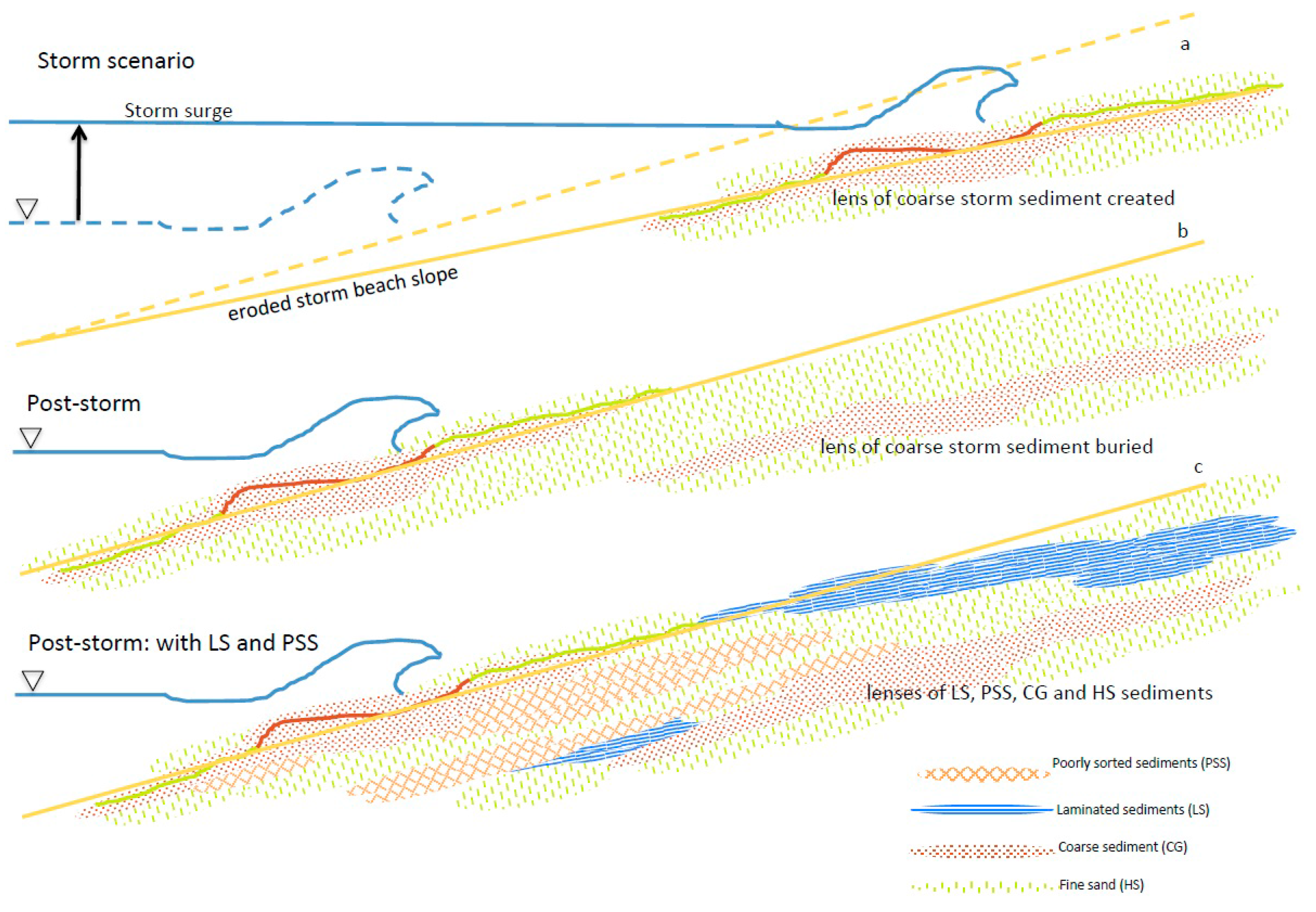
© 2016 by the authors; licensee MDPI, Basel, Switzerland. This article is an open access article distributed under the terms and conditions of the Creative Commons Attribution license ( http://creativecommons.org/licenses/by/4.0/).
Share and Cite
Gallagher, E.; Wadman, H.; McNinch, J.; Reniers, A.; Koktas, M. A Conceptual Model for Spatial Grain Size Variability on the Surface of and within Beaches. J. Mar. Sci. Eng. 2016, 4, 38. https://doi.org/10.3390/jmse4020038
Gallagher E, Wadman H, McNinch J, Reniers A, Koktas M. A Conceptual Model for Spatial Grain Size Variability on the Surface of and within Beaches. Journal of Marine Science and Engineering. 2016; 4(2):38. https://doi.org/10.3390/jmse4020038
Chicago/Turabian StyleGallagher, Edith, Heidi Wadman, Jesse McNinch, Ad Reniers, and Melike Koktas. 2016. "A Conceptual Model for Spatial Grain Size Variability on the Surface of and within Beaches" Journal of Marine Science and Engineering 4, no. 2: 38. https://doi.org/10.3390/jmse4020038




